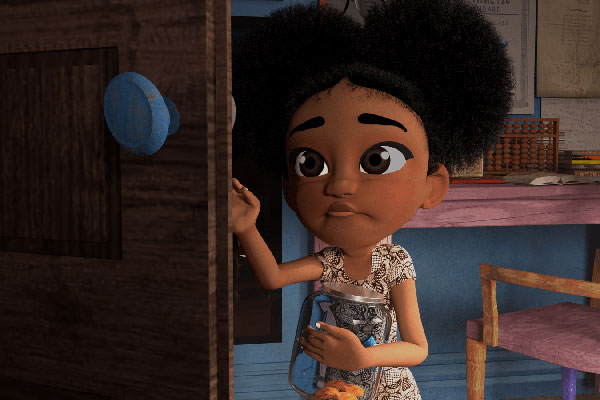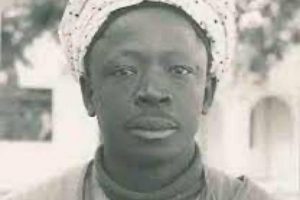How Nigeria’s first feature length animated movie was made
Posted by Timige, On 13 Dec, 2020 | Updated On 7 Dec, 2021 No Comments »

When Blessing Amidu, a Lagos-based geologist, first had the idea for a feature-length animated movie in 2016, she paid a prolific Nollywood filmmaker to get the job done. But, after nearly two years and around $40,000 spent, no headway had been made.
With much of the money mismanaged and the quality of work delivered deemed unsatisfactory, Amidu cut her losses and considered paying an animation studio in the US or Asia to produce the movie for her. Predictably, that move proved too expensive and ultimately, beyond reach.
Seemingly at a dead end, she chose to try a more hands-on approach: she set up her own film production outfit, aiming to find the right balance of local creatives to make Lady Buckit and the Motley Mopsters (LBMM)—an animated film about a curious little girl that accidentally gets transported through time. Much of her determination was linked to the fact that the story idea and some of its characters were inspired by her four children, who had themselves become emotionally invested in seeing the film made.
Her new approach inevitably meant taking another shot at making the film in Nigeria but this time, by bringing on a variety of experienced hands to midwife the production process. The first hire for the project was Chris Ihidero, the Lagos-based producer of MTV’s Shuga series and writer of Hush and Forbidden, two popular TV dramas produced by Africa Magic, an arm of MultiChoice, the African pay TV giant. “It felt like a good challenge when she sent me the screenplay,” says Ihidero, who joined Amidu’s crew as consulting producer.
After signing on in August 2019, Ihidero set about recruiting a director to bring the animated film idea to life. There was just one problem: “Nobody in Nigeria had done an animated feature film,” he tells Quartz Africa. After consulting industry contacts, Ihidero and Amidu settled on Adebisi Adedayo, an animation veteran with experience in making animated short films and visual effects for live-action productions, most notably in Game of Thrones’ final episode of season seven.
Behind the scenes
When released on Dec. 11, Lady Buckit and the Motley Mopsters will be Nigeria’s first feature length animated film and will mark a major milestone for a blossoming comic and animation scene which has increasingly seemed primed for the mainstream.
Indeed, Lagos, Nigeria’s commercial capital, has hosted an annual Comic Con since 2012 with creators showcasing characters and stories in front of audiences that have since grown from hundreds to thousands. In October 2019, YouNeek Studios also made a mark by releasing a 15-miute pilot for Malika: Warrior Queen—an animated film inspired by a 16th century queen in northern Nigeria—to wide acclaim.
For its part, Lady Buckit and the Motley Mopsters will star some of Nollywood’s most recognized actors, including veterans Patrick Doyle, Bimbo Akintola and Kalu Ikeagwu. Set in Oloibiri, a town in Nigeria’s south where oil was first discovered in 1956, the movie’s dialogue will also feature local Nigerian languages Ijaw, pidgin and Yoruba in addition to English.
The process of making the film began in November 2019 with Adedayo and his team—made up entirely of graduates from a training school for animators he has run since 2014—given a target of turning the film around within a year. But those initial plans were partially derailed by the Covid-19 outbreak and the resulting lockdowns in Lagos. “That took out of our production time and was one of the biggest challenges we had,” Adedayo tells Quartz Africa.
To meet up with the agreed schedule which was, in itself, a tall order, Adedayo managed a hectic process through several workarounds.
With character sketches already existing from Amidu’s first trial to make the film, Adedayo’s team started off by creating concept art and more character designs before working with Ihidero to rework the film’s script to make it more fitting for animation.
“Once that was done, we began with the story boards for the entire movie and that took about four months. But while that was ongoing, character creation in 3D was also going on and the film environment was also being created at the same time,” he says. “We had about six processes going on at the same time. We were working on several parallel processes that were all interconnected and running at the same time—that’s how we were able to pull this through.”
Ultimately, it took a team of 29 animators to manage these processes over the eight months it took to finish the animation. “Editing was also happening in parallel—before the final frame was being rendered, the rest of the film had already been edited,” Adedayo tells Quartz.
Working concurrently across several processes that typically happen consecutively meant keeping 18 high-performance computers on around the clock. But making the movie in Lagos meant the crew also faced unique, local challenges, especially Nigeria’s infamous power cuts. The solution was to keep the studio running on four large, 8 kilovolt-amps diesel-powered generators for nearly a year through the process of designing, animating, editing and rendering. “You just can’t rely on grid power when you’re working on a task like this,” Adedayo says.
Big picture
Like most animated film projects, Lady Buckit and the Motley Mopsters faced the albatross of a lack of funding which is particularly acute for creatives in Nigeria. Having failed to secure backing from financial institutions “who couldn’t understand what we were trying to do,” Amidu, a veteran of Nigeria’s oil and gas industry, chose to self-fund the production which, she says, eventually came to a cost of just under $1 million.

The hope however is that the film serves as a springboard for other players in the niche by showing the scale of local capabilities.
“It’s important to note just how huge of an accomplishment this is,” says Roye Okupe, founder of YouNeek Studios which is working on plans for its own full-length animated movie as well. “My hope is that this sheds light on, and brings much-needed attention to, the amazing amount of talented artists that exist in not just the Nigerian creative industry but the African creative industry as a whole.”
But any chance of long-term progress inevitably revolves around the subject of funding. “We need more investors in this space,” Okupe says. It’s a subject he’s familiar with having bootstrapped a bulk of production costs for the release of the pilot for Malika: Warrior Queen last year.
“Often time, the difference between a local production and international standards is funding,” Ihidero says. “But there are people who can do amazing things here if properly funded and given the time required. I’m hoping this film makes people aware of the endless possibilities of creative people in Nigeria.”
The knock-on effect of more funding for the space will also be more opportunities for creators like Adedayo and the next generation of animators. So far, there’s already one sign of the film’s impact on the creative industry: six new students signed up for Adedayo’s training school for animators soon after the film’s trailer was released.
For her part, after finally getting her film done, Amidu and her new production studio are not slowing down. A story idea for a sequel is already in the works as are plans for animated drama projects. While the film will be screened across Nigeria, cinematic releases are also planned in parts of North America and the UK—both home to large swathes of Nigeria’s vast diaspora.
Amidu and her team will likely be banking on the increased focus on quality, which has seen recent Nollywood movies score big at local cinemas, to count in their favor. But there’s a lingering question about what appears to be the high-risk venture of a cinematic release amid a global pandemic which may yet see potential cinema goers avoiding public spaces.
Despite those fears however, Amidu insists postponing the film’s release was not in question. “After all hard work, there was no way we were going to push this back,” says Amidu. “We’ve already gotten this far.”
Do you have question or opinion about this post? Make it in the comment below.
Please Share with Your Friends/Followers
Get Current with Nigeria, Subscribe Now!
Related Posts
Previous Post: « Nigeria To Be Investigated By The International Criminal Court
Next Post: First Nigerian Animation Movie Premier in Cinema »
- This Nigeria World Post is Tagged with:
- First Nigerian |
- Nigeria Entertainment |
- Nigeria Movie










Leave a Reply